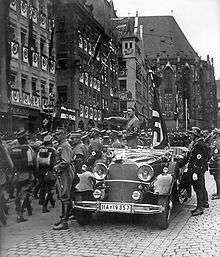Jakob Grimminger
Jakob Grimminger (25 April 1892 – 28 January 1969) was a German Nazi Party and Schutzstaffel (SS) member, known for being the standard-bearer of the Blutfahne, the centrepiece flag of the Nazi movement's ceremonies.
Jakob Grimminger | |
|---|---|
 Adolf Hitler at the SA parade in Nuremberg, September 1935. Franz Pfeffer von Salomon and Hermann Göring stand to the left; SS-Sturmbannführer Jakob Grimminger stands behind the car. | |
| Born | 25 April 1892 Augsburg, Bavaria, German Empire |
| Died | 28 January 1969 (aged 76) Munich, West Germany |
| Allegiance | |
| Service/ |
|
| Rank | SS-Standartenführer |
| Battles/wars | |
Early life
Grimminger was born in Augsburg, Bavaria and entered the Imperial German Army when he was sixteen years old. He served during World War I as a mechanic in an air regiment from 1914 and 1917. He fought in the Gallipoli Campaign. He also served a year in Palestine after which he returned to Germany. Having been awarded the Iron Cross (second class), Bavarian medals and the Turkish Iron Crescent, Grimminger was discharged from the German Imperial Army in 1919 after its defeat.[1]
Nazi Party activity
Grimminger joined the Nazi Party (NSDAP) in 1922 and became a member of the Sturmabteilung (SA). He took part in street-fighting in Coburg in 1922 and in the Munich Beer Hall Putsch of 8 November 1923. After serving in the Brown House, the general headquarters of the NSDAP, he was selected in 1926 to become a member of the Schutzstaffel (SS). Grimminger was promoted during his service in the SA and the SS, finally reaching the rank of SS-Standartenführer (equivalent to colonel). As a member of the SS, he was appointed to carry the blood-stained Blutfahne from the Munich Putsch. He was decorated with the Golden Party Badge, the Blood Order (no. 714), and the Coburg Badge, three of the most prized decorations of the NSDAP.[2] The "Blutfahne's" fate, which Grimminger was the guardian of, after the fall of the Third Reich in mid-1945 is unknown.[3]
Post World War 2
Grimminger survived World War 2, and was put on trial by the Allies in 1946 for being a member of the SS and ceremonially carrying the Blutfahne for nineteen years as a part of the propaganda of the Nazi Party. For this, he was not sent to prison, but all of his property was confiscated. In later life, he reportedly attempted to enter politics and served as a Councillor in Munich, his past however prevented him from continuing this career. He died in obscurity in Munich in 28 January 1969 aged 76. His body was buried in Munich's Waldfriedhof, but the grave was subsequently reclaimed, and his body was relocated to an unmarked grave in Herzebrock-Clarholz.[4]
Notes and references
- Notes
- Profile of Grimminger on the 'WW2 Gravestone.com' website (2019). https://ww2gravestone.com/people/grimminger-jakob/
- Dombrowski, Hanns (1940), Orders, Ehrenzeichen und Titel.
- 'The Mystery of Hitler's Blood Flag', mini-documentary film by Mark Felton. published on Youtube 4 March 2019. https://www.youtube.com/watch?v=6h6GhhTcUYw&t=3s
- Biographical entry for Grimminger, 'WW2 Gravestone.com' website (2019). https://ww2gravestone.com/people/grimminger-jakob/
- References
- ^ "Flags of the World". Retrieved December 27, 2005.
- ^ "Internet Movie Database entry on Jakob Grimminger". Retrieved December 27, 2005.